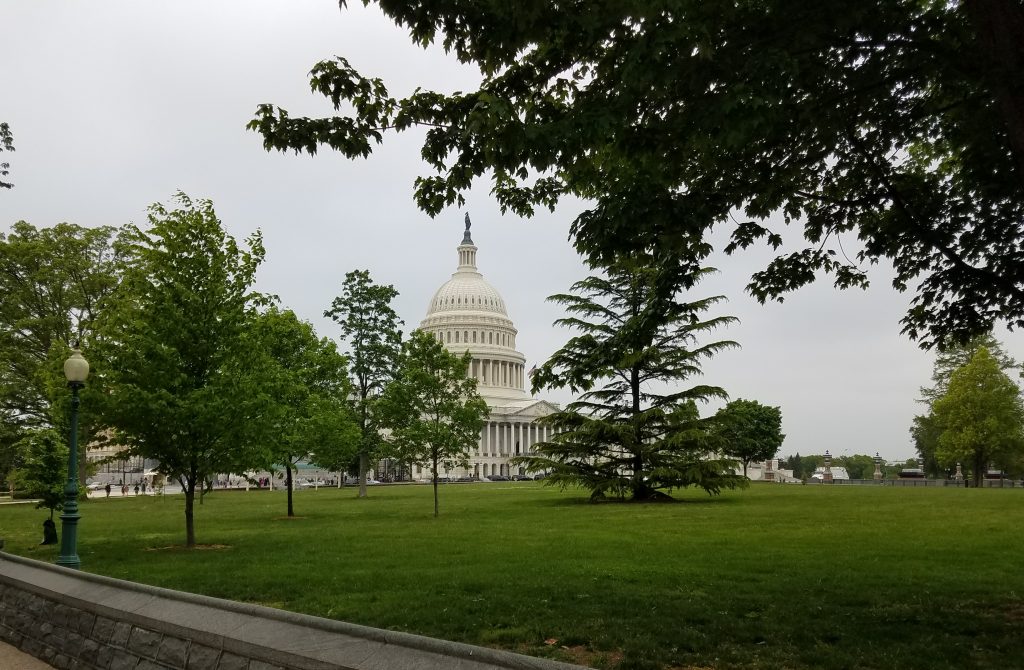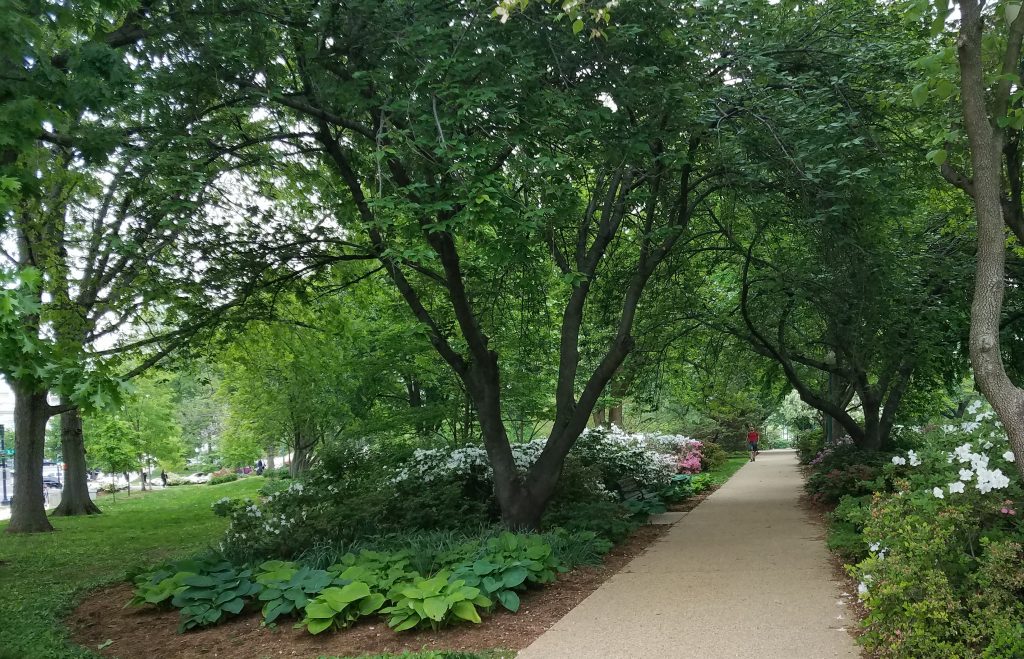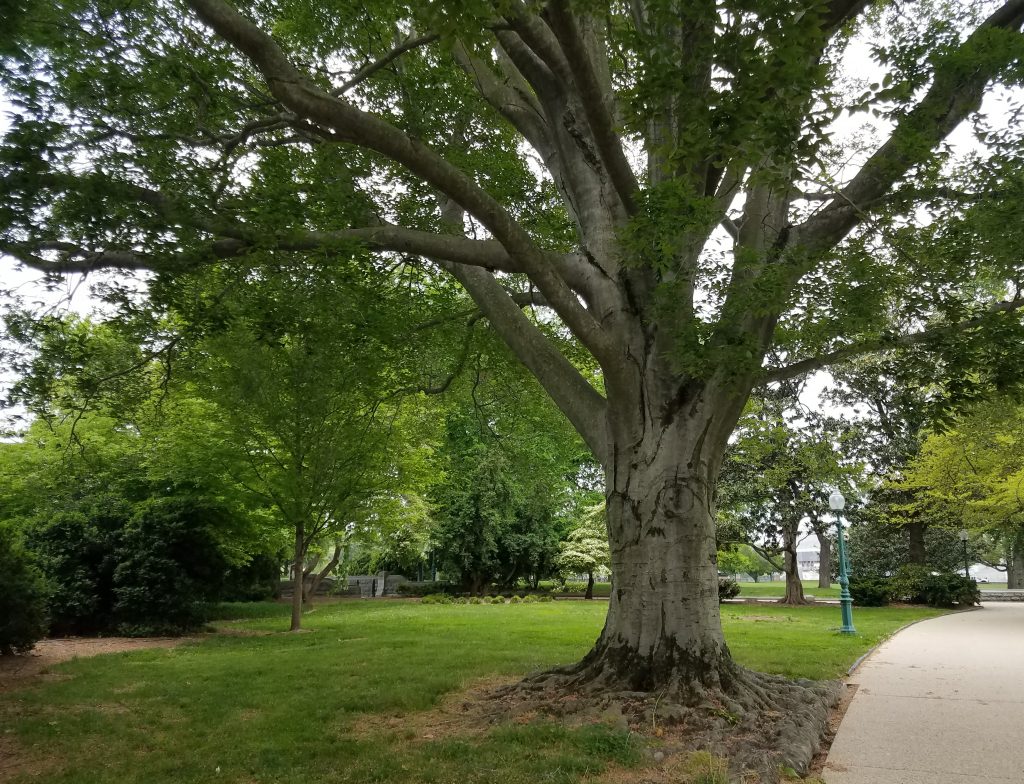
Our day of lobbying went well. We visited staffers from Senators Tim Kaine & Mark Warner, as well as from Representatives Gerald Connolly, Morgan Griffith, Abigail Spanberger, Rob Wittman & Ben Cline. I met a few of the staffers before and they remembered me. I understand that they have notes and do prep, but it is also because of my unique business card. All of those who remembered me mentioned the card. In any case, I am impressed that they took the time to welcome me back. Good constituent relations. My representative is Gerry Connolly. He used to be our Fairfax County supervisor. He is a good guy.
Proud to be American
All the staffers were friendly and listened to our entreaties with interest and attention. It would be unfair to characterize their responses in greater detail, except to note that Ben Cline’s district included our Virginia Tree Farmers of the Year in Highland County, and his staffer was especially interested in maybe meeting them. I can and will, however, list what I told them.
The facts tell; the story sells
I studied the night before the list of the bills we want our Virginia delegation to support and positions we hope they will take, but I decided that I would touch on those things, but that I could give them the leave behind material for details. Instead, I decided to tell my own story, what I think is important about the way we do forestry. The things I really understand and really care about.
Trees are more than wood and forests are more than trees. I started with this mantra, and elided into the triple bottom line, i.e. every endeavor must be good economically, environmentally and for the community. We need the balance and if we fail on any one of them, we fail in general. The challenge for private forest owners, however, is that if we do the ecological and community parts well, we sometimes have problem with the economic part. To address this, I am grateful for government programs.
I gave the example of our own NRCS grants to restore longleaf, protect soils, plant pollinator habitat and manage with patch burns. All these things, I explained, are things I want to do, but could not afford absent the cost shares. For example, pollinator habitat seeds can cost around $300 an acre. I could not justify spending that much money on too many acres. The cost share is exactly that. It costs me time & money to carry out these activities, but it costs less with the help I get. I also greatly value the help I get in the form of advice and planning. The partnership is more powerful than either side could do.
My land is part of a big system
This fed into one of our “asks.” We want support for landscape scale projects for family forests. My land is part of a larger ecosystem. My land affects the health of the big ecosystem and my land’s health is affected by the larger system, so I care about that. Examples of landscape scale projects include longleaf restoration (one I am working on), wildfire mitigation and the white oak initiative.
I went into the white oak initiative in a little more detail both because I am fond of white oak and because it is easy to illustrate. There is today no shortage of white oak. The problem is with it age structure. We have old growth and middle-aged white oak, but there is not enough of the new generation. This is because white oak requires disturbances to allow the right amount of light. Doing this is not rocket science, but it needs to be done. It takes 50-80 years for a white pine to mature, so what we do now matters a couple generations hence.
The hook with white oak is bourbon. ALL bourbon must be aged in new white oak barrels. Other sorts of wood leak. All the color and most of the taste of bourbon comes from the white oak barrels. When you take a drink of bourbon, you are tasting the decades of oak. Even people who do not drink bourbon can appreciate this. In case they do not, wine, most cider and some beer are also oak wood aged.
Landowners cannot by themselves defend their land against invasive insects and plants. The government role here is to limit spread, anticipate invasions and research ways to adapt or overcome the threats. This is often done with grants to universities or to state and local governments. I think this is one of the most important things that government does. The challenge is that it is so important but often not urgent. If not done this year, you might not notice.
It is like nutrition and exercise. Skip a workout and eat nothing but donuts for a day or two and neglecting your health doesn’t much hurt. Neglect it for a long time and it is deadly.
Thanks for past success
We thanked Congress for the Farm Bill, which included lots of forestry friendly factors. One of the parts important to Virginia is the Sustainable Forestry & African American Land Retention program. This is aimed to help African American forest owners whose families owned and often still own forest land. The problem is that many are absentee owners and titles are unclear, with many descendants of the original landowners owning a small piece. This makes it difficult to manage the land and nearly impossible to take advantage of the many government programs alluded elsewhere, state and Federal.
We also thanked the Congress for the wood innovation grants, that have helped develop important innovations like Cross Laminated Timber (CLT) and for passing the wildfire fix, and I talked a little about the need for cross-boundary hazardous fuels projects, that will help private forest owners manage fire risk, and for the Community Wood Energy Program (CWEP).
If I sum up our talks, I think we were talking about the big picture, how our lands fit with programs and how the program fit with our lands. We got to know more about each other and understand better.
As Aldo Leopold said, “we can only be ethical in relation to something we can see, understand, feel, love, or otherwise have faith in.”
More information on the American Forest Foundation at this link.
Pictures show Capitol on the morning of the visit. Next is a beautiful big beech tree on the grounds and a garden path.


